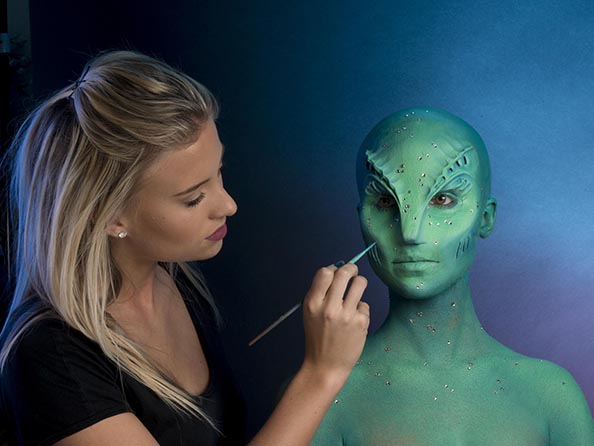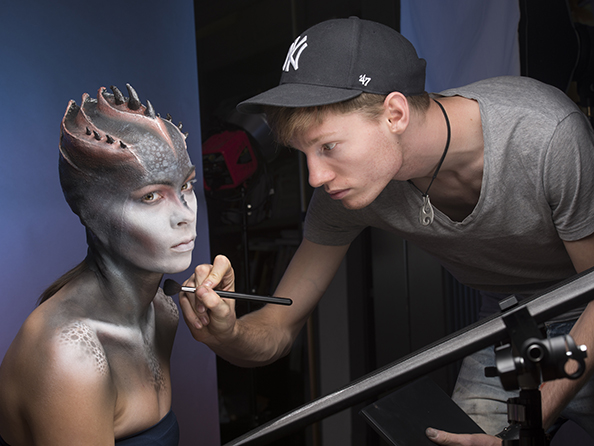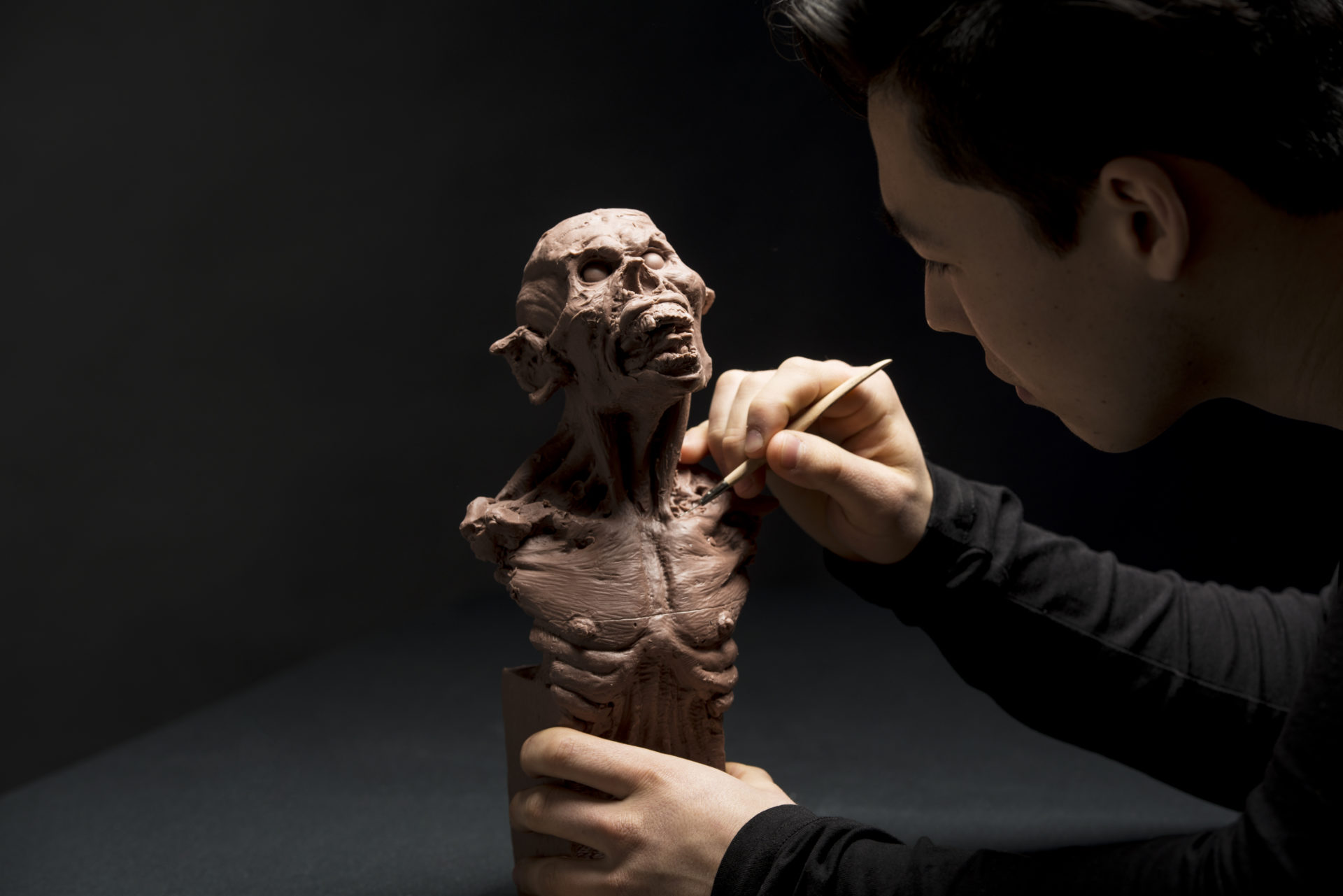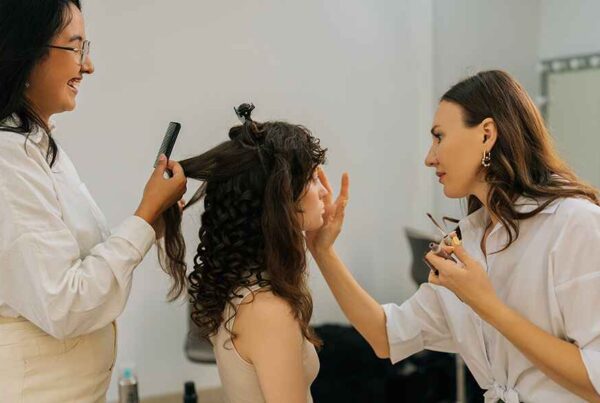
Special effects makeup is an amazingly diverse field that encompasses everything from film & television to digital and special effects. Your education comes from courses but also time in the field.
In the modern age of technology, special effects makeup artists have a wide variety of tools to create realistic-looking characters, creatures, props, and environments.
This blog post covers the skills taught in a special effects/digital FX course. The education offered by a renowned special effects makeup school can help someone excited about this industry build a strong foundation for their future.
What Is Digital FX Makeup Artistry?
Digital FX makeup artistry refers to the art of creating believable characters using digital effects. It’s a broad term that includes everything from traditional 2D animation to 3D modeling and rendering, visual effects, motion graphics, video editing, and more.
Today’s world offers a wide variety of special effects makeup artist jobs. Some work exclusively in the digital realm, while others specialize in analog and digital techniques.
These are some of the most common areas of focus within the digital FX makeup artistry field:
- Character Animation: Creating digital versions of live-action characters.
- Creature Design: Making digital animals, monsters, aliens, robots, etc.
- Environment Creation: Creating digital worlds, landscapes, cities, etc.
- Motion Graphics: Combining CG and live-action footage elements to create unique visuals.
- Visual Effects: Using computers to enhance or change reality.
- Video Editing: Manipulating images using specific editing tools.
- VFX Compositing: Combining multiple shots to create one cohesive image.
Digital FX Makeup Artist in the Film & Television Industry
Film & TV makeup artists use their special FX makeup kit to transform actors into characters by applying prosthetic makeup and other forms of special effects. They may be responsible for creating characters, including humans, animals, aliens, robots, monsters, superheroes, villains, historical figures, and the like.
When working on a movie or TV show, the special effects makeup artist must ensure that the finished product looks realistic enough to convince viewers that the character is real. The makeup artist must pay attention to detail so that the transformation doesn’t look unrealistic and matches the quality of what it is they’re filming.
Skills Taught in Digital FX Makeup Courses
To keep up with today’s technology and consumer expectations in the makeup industry, many sought-after special effect makeup schools like CMU College offer courses in special FX makeup artistry. These programs provide training and practicums to help students learn how to utilize software and techniques best to create realistic characters.
In addition to more traditional special effects makeup courses, students learn how to apply makeup digitally and manipulate photographs and videos to create realistic-looking results.
An SFX makeup kit includes digital and real-life tools.
Here are a few of the skills taught in the specialized courses for FX makeup:
Life Drawing
To become an expert special FX makeup artist, you must understand anatomy and proportion. Life drawing art courses help students understand these concepts better than just looking at photos or drawings.
This course teaches students how to draw realistically without relying on photographic reference material. In this class, students learn how to capture the essence of an object through observation and experimentation.
Figurative Sculpting Techniques
The figurative sculpting techniques taught in digital character makeup courses help students learn how to translate a subject into a three-dimensional sculpture. These skills enable makeup artists to make their creations appear more realistic than those created using traditional methods.
For instance, a special effects makeup student who wants to create a mythical character might start by sketching a rough outline of its head and body. Then they would add details such as scales, horns, claws, and more. Finally, they would add finishing touches such as eyes, nostrils, and any additional facial features that bring the character to life.
Design Elements in Digital Makeup Artistry
Digital makeup artists use various design elements to create unique special makeup effects. The best way to master these techniques is to have hands-on experience under the guidance of a professional makeup artist. Here are the top design elements taught at CMU College:
Anatomy
When creating a character digitally, one thing that makeup artists must have a grasp on is anatomy. Every limb of the body has shape and depth to it; our limbs look different when they’re both flexed and relaxed. Having an understanding of how the body works and how it looks as it changes is crucial to being able to create realistic characters both through prosthetics and software programs.
Emotions
A special effects makeup artist must know how to use makeup to create a credible emotional expression. Being able to do this requires an understanding of colours, shading, and texture.
By understanding the various details that emotion can create in the face of an individual, special effects makeup artists are able to create looks that convey realistic emotions. This is especially important for individuals creating characters through software programs.
Poses and Posture
Alongside anatomy, special effects makeup artists need to have an understanding of poses and postures. Again, the way that a body stands and moves can make a big difference in what one sees. By having an understanding of how certain stances create shadows and move on an individual, makeup artists interested in special effects are able to design and mimic real life movement in their characters.
Clothing
Special effects makeup artists need to understand clothing design elements well. This knowledge includes knowing what kind of clothes to wear, where to place buttons and pockets, and how to accessorize outfits. Alongside that, designers must also know how these clothes fall when being worn so that they’re able to recreate it in their stylings.
Ultimately, an understanding of clothes can help provide additional depth to the character that one creates, not just in who they are as a character, but how they look when the look is completed.
Textures
Another crucial skill of a special effects artist is texture. Whether using software to create a character or applying makeup directly to an individual to create the character, the texture provides additional depth. This goes for both the details of a character’s face and the clothing that they’re wearing.
A great example of where texture plays a part in makeup would be details like cuts or abrasions. A cut isn’t a one-dimensional thing; cuts can be deep, and scabs can be textured and risen. The dimension and texture of the makeup used to create these cuts can make them look all the more realistic.
Practical Creature Design
Creature designers often rely on special effects to help tell stories. Some popular special effects include makeup, creatures, and props. Working with directors and producers, creature designers create new worlds and bring life to imaginary beings.
Understanding the different types of special effects can help a professional makeup artist become a better creature designer. From the way that a creature stands to the emotions it conveys, a creature designer is in charge of bringing this character to life.
As a beginner, a special effects makeup artist might want to focus on one type of special effect at a time. This aids SFX makeup artists in building a solid career foundation.
Using Photoshop
The makeup industry also uses Photoshop as a creative tool to enhance photographs. The process involves taking a photograph, manipulating the image, then adding special effects such as lighting, filters, textures, etc.
Photoshop is also used for retouching images. Retouching means making minor changes to an image, like removing blemishes or changing skin tone.
An SFX makeup artist is well-equipped to tackle any work that comes their way with this skill. They can take a photograph, add special effects, adjust colour, change the size of objects, and even manipulate facial features.
Digital Character Design: ZBrush Sculpting
Sculpting enables artists to shape digital models into lifelike sculptures like working with an actual ball of clay in the real world. In ZBrush, a digital sculpting application, artists use brushes and other tools to shape virtual clay. As a result, they can smooth away unwanted bumps and wrinkles, add details, and even paint over them.
Special effects makeup artists need this skill because they are responsible for giving digital models a three-dimensional look. For example, a character’s face may be made of thousands of polygons. Still, a special FX makeup artist can give it form and detail.
Both pros and beginners can use ZBrush. Beginners can get started quickly with introductory lessons, while experienced users can dive deep into advanced techniques.
Career Planning & Digital Portfolio Creation in Digital Makeup Artistry
A fantastic way to display work to potential employers is through a portfolio. Your portfolio should demonstrate your creativity, technical education, and artistic abilities. Professionals regularly update their portfolios with completed looks.
A good online portfolio is more than makeup, fake blood, and liquid latex. It contains the best work of the special-effects makeup artist. In addition, it should contain projects that showcase your strengths.
To help students pursue their careers effectively, CMU prepares an SFX makeup artist for the job market. They do this with comprehensive career planning and a digital portfolio creation program.
In addition, you will receive personalized guidance and training on building a successful portfolio for a successful career.
Enroll in the Digital FX Course at CMU
The career path for a special effects makeup artist is wide open with opportunities. If this is a career path that you’re interested in pursuing, the first step is enrolling in a high-quality makeup artistry program.
CMU College offers a distinctive Digital FX Makeup Effects Artist Program that nurtures you for a thrilling career in the expanding makeup artistry industry. This instruction ranges from digital and practical creature design to Photoshop and ZBrush digital sculpting. Take a look at our student success stories today to see how our Digital FX Course can get you started in this exciting career.






